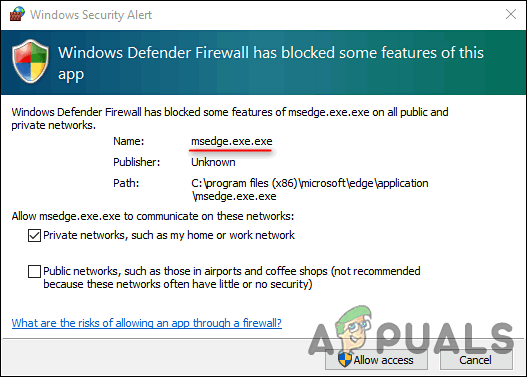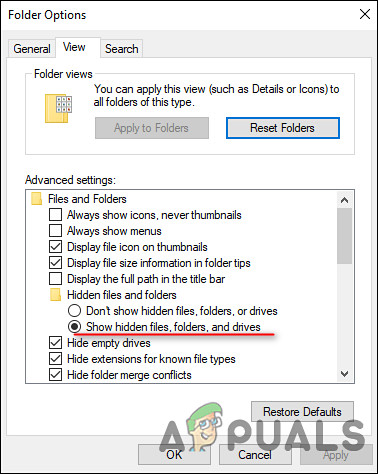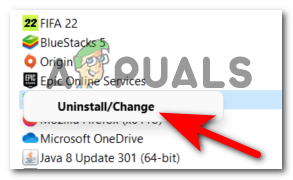What is “msedge.exe.exe”? and How to Fix It?
Recently, several users reported that Microsoft Defender Antivirus displays a security alert asking if you wish to “msedge.exe.exe” to have access to use all features on private/public networks on their computers, which looks quite suspicious.

If you do not know already, ‘msedge.exe’ is a safe and harmless executable file for Microsoft Edge. However, certain Trojan Horses and Spyware threats disguise their processes as msedge.exe or files with a similar name, allowing them to remain undetected for a long period of time (they can sometimes go unspotted forever). These files are often responsible for strange behaviors in your computer, including issues like the msedge.exe.exe pop up in Windows.
The legitimate msedge.exe files are located in C:\Program Files (x86)\Microsoft\Edge\Application\. Any similar file found anywhere else is probably a potentially dangerous file mimicking the actual msedge.exe file/process. If you are in a similar situation, you are in the right place because in this guide, we have listed some easy ways to resolve the issue once and for all. Let’s begin!
Check the Msedge.exe Details
The first step is to verify that the process is stored where it should be. As a default and legitimate executable file, ‘msedge.exe’ should be placed in the C:\Program Files (x86)\Microsoft\Edge\Application\ folder. Anything else could indicate malicious activity.
You can also check if there are multiple msedge.exe files on the computer. The easiest way of doing so is via the search bar in your File Explorer. Simply head over to the primary drive (C: in most cases) and use the search field to check for any duplicate files. If any such files are found outside of the folder path we discussed above, remove or rename them immediately.
In case certain files are hidden in your File Explorer, follow the steps mentioned below:
- Launch File Explorer and head over to This PC.
- Now click on Options in the toolbar and select Change folder and search options.

- In the Folder Options window, head over to the View tab and under Advanced settings, click on ‘Show hidden files, folders, and drives’.

- Once done, hit OK to save the changes.
- Now launch the primary drive and use the search bar to find any msedge.exe.exe process.
- If you find any, right-click on it and select Delete. The msedge.exe.exe pop up should not occur again.
Remove the Malware via Task Manager
Another easy way to remove the potentially dangerous msedge.exe.exe file is via Task Manager.
If you do not know already, Task Manager allows you to keep track of the applications and processes running on your computer, as well as the overall status of the machine.
Here is what you need to do:
- Type Task Manager in the search area of your taskbar and hit Open.
- Inside the Task Manager, head over to the Details tab and look for any msedge.exe processes that might not be related to Microsoft Edge.
- If you find any, right-click on them and select Open file location.

Launch file location of msedge.exe.exe - Now right-click on the faulty file and select Delete. Click on Yes in the confirmation prompt if one displays.
- Alternatively, you can also open the Programs and Features window from the search tab on your taskbar.
- In the next window, right-click on any potentially untrusted programs and select Uninstall.

Uninstall the encryption program
Hopefully, this will fix the msedge.exe.exe issue and remove any relevant potentially dangerous files found.
Rename the File
In some cases, you might not be able to delete the msedge.exe file. This typically happens when the malware infects the file, making it impossible for the users to remove it completely.
If this scenario is applicable, you can try renaming the file and then reinstalling Microsoft Edge. This fix worked for several users, which is why we recommend giving it a shot. However, before you proceed with this method, we recommend creating a restore point, just to be safe. By doing so, you will be able to restore your operating system to its current state if something goes wrong during the process.
Here is what you need to do:
- To begin with, boot Windows into Safe Mode.
- Once done, navigate to ‘c:\program files (x86)\microsoft\edge\application\’ and right-click on the msedge.exe file.
- Select Rename from the context menu and rename this file to anything else like msedge1.exe or msedgeold.exe.

Selecting Rename - Now, restart to get out of Safe Mode and upon reboot, launch any browser other than Microsoft Edge.
- Navigate to the official Microsoft website and reinstall Edge.
- The msedge.exe file should be created in the same directory and you should not face the msedge.exe.exe pop up again.





